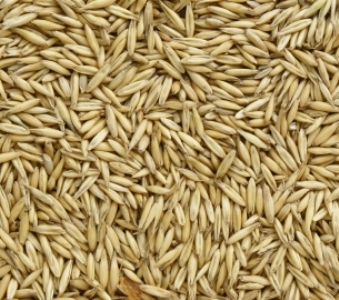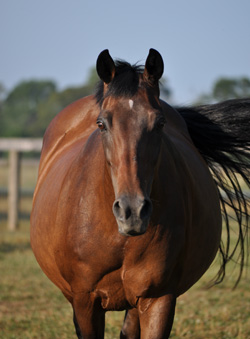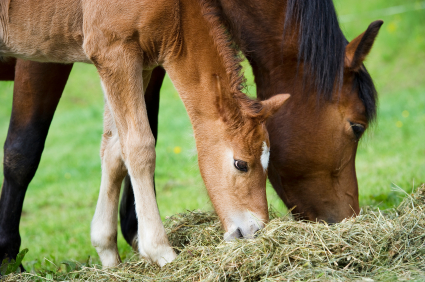 Nature is a curious thing, often rigged in the favor of the next generation over the success of current adult individuals. Some interesting metabolic changes occur during a horse’s pregnancy that are very similar to the changes that occur during a human pregnancy that in both cases favor the unborn individual. While these shifts in metabolism are crucial to the development of the fetus, they may have devastating consequences for some mares and in certain cases may lead to the unborn foal’s demise.
Nature is a curious thing, often rigged in the favor of the next generation over the success of current adult individuals. Some interesting metabolic changes occur during a horse’s pregnancy that are very similar to the changes that occur during a human pregnancy that in both cases favor the unborn individual. While these shifts in metabolism are crucial to the development of the fetus, they may have devastating consequences for some mares and in certain cases may lead to the unborn foal’s demise.
How Progesterone Effects Insulin
Progesterone is often called the “pregnancy hormone” due to the fact that it helps develop the uterus during early pregnancy and then prevents contractions. Without adequate progesterone a pregnancy may not “take” and miscarriages can result. However, it works as an antagonist to insulin, the hormone that controls blood sugar levels. This means that during pregnancy cells become less sensitive to the actions of insulin resulting in a form of insulin resistance.
This shift is a necessary and important adaptation that insures that the energy demands of the developing fetus are met and is a temporary state for the mare. By reducing sensitivity to insulin in the mother it is less easy for circulating glucose to be taken-up by the mother’s muscle tissue and liver which leaves more available to pass through the placenta to the fetus. This change in glucose management occurs gradually but is highest during the third trimester which is the fetus’ major growth period.
 While research into this phenomena is abundant in people due to concerns over the development of gestational diabetes, in horses the data is limited. A study of twenty-two pregnant and ten non-pregnant Thoroughbred mares looked at response to a frequently sampled intravenous glucose tolerance test (FSIGTT). All mares were tested at approximately 28 weeks of gestation and at that point grouped by age and body condition score and assigned randomly to a feeding protocol of either a high starch or a high fat high fiber diet. At 28 weeks, the pregnant mares had slower clearance of glucose from their blood despite having higher circulating levels of insulin. This was further exacerbating in later tests at 47 weeks for the pregnant mares that were fed the higher starch diet versus pregnant and non-pregnant mares that had been fed the high fat high starch diet. Relative to the non-pregnant mares these pregnant mares were insulin resistant from day 150-270. It should be noted that insulin resistance may occur earlier in pregnancy but to date this has not been studied.
While research into this phenomena is abundant in people due to concerns over the development of gestational diabetes, in horses the data is limited. A study of twenty-two pregnant and ten non-pregnant Thoroughbred mares looked at response to a frequently sampled intravenous glucose tolerance test (FSIGTT). All mares were tested at approximately 28 weeks of gestation and at that point grouped by age and body condition score and assigned randomly to a feeding protocol of either a high starch or a high fat high fiber diet. At 28 weeks, the pregnant mares had slower clearance of glucose from their blood despite having higher circulating levels of insulin. This was further exacerbating in later tests at 47 weeks for the pregnant mares that were fed the higher starch diet versus pregnant and non-pregnant mares that had been fed the high fat high starch diet. Relative to the non-pregnant mares these pregnant mares were insulin resistant from day 150-270. It should be noted that insulin resistance may occur earlier in pregnancy but to date this has not been studied.
Pregnant women are routinely screened for gestational diabetes due to known clinical complications and diagnosis is not uncommon. In women insulin sensitivity decreases by about 60% during pregnancy. However, no such routine screening occurs in pregnant mares. Typically, in healthy mares decreased sensitivity to insulin during pregnancy causes no obvious clinical problems. However, for mares that suffer from equine metabolic syndrome or that are insulin resistant prior to pregnancy, the further decrease in insulin sensitivity and the resulting increase in circulating insulin can increase their risk of developing laminitis. In severe cases there may be fetal compromise and abortion.
Equine Metabolic Syndrome in Broodmares
Equine metabolic syndrome is diagnosed when a horse is obese, has elevated insulin and a history of or current laminitis. Due to the interplay between obesity, insulin resistance and laminitis mares with a history of obesity may have an increased risk of laminitis when pregnant. It is therefore very important that body condition be considered during a breeding soundness exam. Performing a metabolic screen to measure insulin is also advisable. Other areas often overlooked but that should be components of a breeding soundness evaluation include assessing hoof health. Looking for evidence of past laminitis is especially important which may be evidenced by thin or dropped soles, stretching in the white line, seedy toe and rings on the hoof wall that drop down as they approach the heal. Sharing your mare’s health history with your vet and farrier/trimmer are a vital component of creating a management plan.
 Should you and your vet decide to breed your at risk mare careful management is a necessity. As calorie restrictions should be avoided during pregnancy unless absolutely necessary reducing obesity prior to breeding is key. High starch feeds particularly in the later stages of pregnancy when insulin insensitivity is greatest should be avoided. This goes against many of the traditional broodmare feeding strategies where grain intake tends to be increased during the third trimester. Instead the mare’s condition should be maintained with good quality hay and a high protein ration balancer and if greater calorie intake is required low starch feeds that favor highly digestible fiber should be utilized. High fat feeds have been shown to induce insulin resistance in healthy horses and therefore care should be taken in feeding them to pregnant mares with known metabolic issues.
Should you and your vet decide to breed your at risk mare careful management is a necessity. As calorie restrictions should be avoided during pregnancy unless absolutely necessary reducing obesity prior to breeding is key. High starch feeds particularly in the later stages of pregnancy when insulin insensitivity is greatest should be avoided. This goes against many of the traditional broodmare feeding strategies where grain intake tends to be increased during the third trimester. Instead the mare’s condition should be maintained with good quality hay and a high protein ration balancer and if greater calorie intake is required low starch feeds that favor highly digestible fiber should be utilized. High fat feeds have been shown to induce insulin resistance in healthy horses and therefore care should be taken in feeding them to pregnant mares with known metabolic issues.
Avoiding high starch feeds when feeding pregnant mares may have additional benefits even for mares with low risk of insulin resistant associated health issues. In humans and rats changes in the intrauterine environment have been linked to negative health consequences later in life. Based on the studies in other species, there is speculation that feeding diets high in starch to pregnant broodmares may put their foals at increased risk of developing osteochondrosis (OC). The thinking being that the mare’s insulin sensitivity and the subsequent modification of foal’s metabolism in utero may lead to metabolic issues later in life such as OC and equine metabolic disease.
Recent Research
Work carried out at the University of Queensland and published in 2013 looked at the changes in the relationship in glucose and insulin dynamics in pregnant mares on different diets (low vs high energy) during the last trimester. Insulin levels were also monitored in the mares and their foals from birth to weaning. Additionally, the same researchers looked at similar parameters in mares and foals on a commercial Thoroughbred breeding operation and looked at the insulin dynamics of Thoroughbred yearlings and the incidence of OC. What they found was interesting. A significant inverse relationship existed between the postnatal concentration of insulin in the foal and the mare’s glucose levels during late pregnancy. Meaning that the higher a mare’s glucose levels in late pregnancy, the lower her foal’s insulin values after birth.
 When they looked at a cohort of yearlings born in 2007, 27% of had OC versus 48% that were normal, and those with OC had lower fasting insulin levels than those that were normal. The 2008 yearlings also had data as weanlings and from their dams during pregnancy and similarly those weanlings that had had a lower fasting insulin were significantly more likely to develop OC as a yearling. The mares that had given birth to foals that went on to develop OC as yearlings had had significantly higher plasma glucose concentrations and body condition scores during pregnancy than those mares whose foals were normal as yearlings.
When they looked at a cohort of yearlings born in 2007, 27% of had OC versus 48% that were normal, and those with OC had lower fasting insulin levels than those that were normal. The 2008 yearlings also had data as weanlings and from their dams during pregnancy and similarly those weanlings that had had a lower fasting insulin were significantly more likely to develop OC as a yearling. The mares that had given birth to foals that went on to develop OC as yearlings had had significantly higher plasma glucose concentrations and body condition scores during pregnancy than those mares whose foals were normal as yearlings.
Take Home Message
How pregnant mares are fed during the period of gestational insulin insensitivity therefore has implications not only on the immediate health of the mare but potentially on the long term health of her foal. Owners of broodmares should have a clear understanding of the implications of gestational insulin insensitivity on their mare prior to breeding in order to determine whether breeding is in the mare’s best interests. Managing broodmare condition and avoiding over feeding of high calorie feeds during gestation, especially those high in starches, is an important management consideration that not only protects the mare from potential health issues but may also have far reaching health implications for her foal.
You may also be interested in the following articles:
The Case Against High Starch Feeds for Pregnant Broodmares
Feeding to Avoid Angular and Flexural Limb Deformities in Foals
___________________________________________________________________________________
 Dr. Clair Thunes, PhD takes the guesswork out of feeding horses by helping horse owners create personalized diet plans optimized for health and performance. As an independent equine nutritionist and owner of Summit Equine Nutrition LLC an equine nutrition consulting company she has clients across North America including breeders and performance horse owners. Her Strong Start program is aimed at insuring foals have correct nutrition from conception to first birthday and includes comprehensive growth tracking. She is available for personal consultations either by phone, email or in person. You can find her online at her website www.summit-equine.com or on Facebook by searching for SummitEquineNutrition.
Dr. Clair Thunes, PhD takes the guesswork out of feeding horses by helping horse owners create personalized diet plans optimized for health and performance. As an independent equine nutritionist and owner of Summit Equine Nutrition LLC an equine nutrition consulting company she has clients across North America including breeders and performance horse owners. Her Strong Start program is aimed at insuring foals have correct nutrition from conception to first birthday and includes comprehensive growth tracking. She is available for personal consultations either by phone, email or in person. You can find her online at her website www.summit-equine.com or on Facebook by searching for SummitEquineNutrition.


Log in to join the conversation.